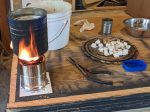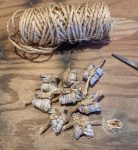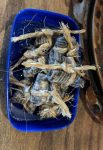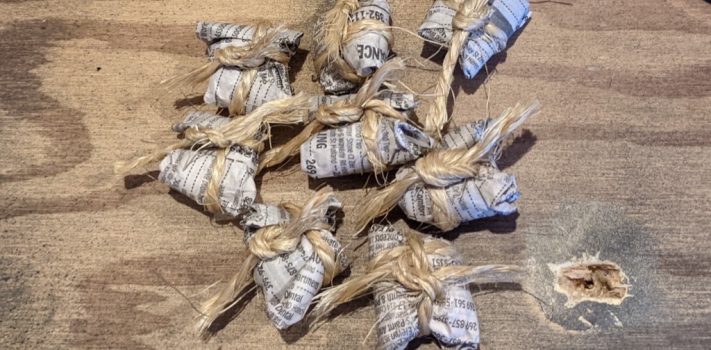In the past, I have generally used a cotton ball with a dab of petroleum jelly as my preferred tinder. During some recent testing, I accidentally got the cotton ball damp. I found out that damp cotton performs very poorly as tinder. This was grounds for some serious thought, since wet conditions are often experienced in the field. I decided it would be wise to try to make a waterproof tinder that could be easily ignited with a ferrocerium rod.
The First Attempt: Cotton in Paraffin
I first tried waterproofing the cotton ball with paraffin. I took a coffee can with an inch or two of water in the bottom, placed a coil of wire in the bottom of the can, and then put the can on a twig stove to heat.
 Next, I took an empty pineapple can, placed a bar of paraffin (approximately 5 ounces) into the can, and placed the pineapple can on the coil of wire in the coffee can, making a crude double boiler. I had recently purchased a large number of bars of paraffin at a garage sale for a grand total of one dollar, so I had a good supply. When the bar of paraffin was fully melted, I removed the coffee can from the heat, but kept the pineapple can with the melted paraffin in the hot water. This kept the paraffin can warm and put it at a more convenient level for working with. It also reduced the risk that I would knock both the can and the stove over at the same time.
Next, I took an empty pineapple can, placed a bar of paraffin (approximately 5 ounces) into the can, and placed the pineapple can on the coil of wire in the coffee can, making a crude double boiler. I had recently purchased a large number of bars of paraffin at a garage sale for a grand total of one dollar, so I had a good supply. When the bar of paraffin was fully melted, I removed the coffee can from the heat, but kept the pineapple can with the melted paraffin in the hot water. This kept the paraffin can warm and put it at a more convenient level for working with. It also reduced the risk that I would knock both the can and the stove over at the same time.
Next I took a number of cotton balls, immersed them fully in the paraffin, removed them with a long-handled needle nose pliers, and set them aside to cool. I treated 20 cotton balls in this way before I ran out of paraffin. While the cotton balls were cooling, I soaked the end of the needle nose pliers in the hot water to remove residual paraffin from that tool, dried it, and put it away.
A couple of days later, I tested the paraffin balls. They were too hard to break by hand, so I cut one in half with a knife. I had hoped that there would be unsaturated fibers in the center of the ball, but the paraffin had soaked all the way through. I could not ignite the ball with a ferrocerium rod, even after scraping the ball with a knife to try to loosen some fibers. The ball ignited easily with a permanent metal match. One half-burned vigorously for more than eight minutes.
The Second Attempt: Petroleum-Jelly-Coated Cotton Balls in Paraffin
I did a search on the web for “water-resistant tinder”, and found an article about “How to Make Homemade Wetfire Tinder” at tacticalintelligence.net. The article suggested saturating cotton balls with petroleum jelly before immersing them in paraffin. I decided to give it a try.
I coated five cotton balls in petroleum jelly, and set them aside for later use. I then lit the twig stove, put the tin can double boiler over the flame, and melted a bar of paraffin.
When the paraffin was completely melted, I dipped the five petroleum jelly/cotton balls into the melted paraffin, and set them aside to cool.
The next day I tested the paraffin-coated, petroleum-jelly-impregnated cotton balls. I was disappointed. Perhaps I used too little petroleum jelly. In any case, sufficient paraffin penetrated to the center of the cotton ball that I was not able to fluff any fibers, and thus was not able to get the ball to ignite with a ferrocerium rod.
The Third Attempt: Paper Wrapped Cotton Balls in Paraffin
 A couple of weeks later, I was ready for another try. I took several pages out of an old phone book. I cut the pages into quarters and wrapped a cotton ball in one of the quarter sheets, folding the seams over themselves several times to make them leak-resistant. I then tied the tiny package shut with a seven-inch length of twine. I found that the seven-inch length of twine was somewhat difficult to tie with my ten thumbs, so after preparing the first two tiny packages in this way, I used eight-inch lengths of twine instead for the six remaining small packages that I made.
A couple of weeks later, I was ready for another try. I took several pages out of an old phone book. I cut the pages into quarters and wrapped a cotton ball in one of the quarter sheets, folding the seams over themselves several times to make them leak-resistant. I then tied the tiny package shut with a seven-inch length of twine. I found that the seven-inch length of twine was somewhat difficult to tie with my ten thumbs, so after preparing the first two tiny packages in this way, I used eight-inch lengths of twine instead for the six remaining small packages that I made.
I then lit the twig stove, put the tin can double boiler over the flame, and melted a bar of paraffin. When the paraffin was melted, I removed the coffee can from the stove. I picked up each of the eight little packages I had made by gripping the twine with a long-handled needle nose pliers, and dipped each package briefly into the melted paraffin. I then set each package aside to cool.
This process used much less paraffin than dipping unprotected cotton balls. The phonebook paper was much less absorbent than the cotton, so the packages became coated with paraffin rather than saturated with it.
A couple of days later it was time to test the packets. I tore the first packet open with my fingers, fluffed the cotton fibers within, and ignited them with a ferrocerium rod. The packet burned steadily for more than 5 minutes.
Then I put a packet in a tin can and poured a couple of inches of water over it. The little packet bobbed to the surface of the water in the can. I removed it from the can, shook off the excess water, tore the packet open with my fingers, fluffed the cotton fibers within, and ignited them with a ferrocerium rod. This packet also burned steadily for more than five minutes.
Next, I put a packet in the can of water and weighted it down to hold it below the surface. I kept the package underwater for 20 minutes before removing it. I then shook off the excess water, tore open the packet with my fingers, and fluffed the slightly damp cotton fibers. I attempted to ignite the fibers using a ferrocerium rod, but was not able to do so. The packets are water-resistant, but not waterproof.
The Fourth Attempt: Petroleum Jelly/Paraffin Mix
For my fourth attempt, I am indebted to SurvivalBlog reader “ATS”. In a comment on an article that SurvivalBlog published on February 4, 2021, ATS described his process for preparing tinder:
“I melt petroleum jelly (PJ) with wax in a double boiler setup, a 13oz PJ as shown along with 4oz-8oz or more of wax. The wax makes the PJ less messy and the PJ makes the wax softer.
Melt the pj and wax and then pour into a gallon-sized zip top bag with 125 large cotton balls (CBs). While the mixture is still liquid gently squeeze the air out and seal the bag. The cotton balls are absorbent and will be saturated with the mixture. Let cool, turning and manipulating the cotton balls so the mixture doesn’t settle and pool.
After the mixture firms up a little bit you can let in air and continue to work it to help keep the cotton balls from bunching up into mass. To use the PJCBs just pull off a piece and it will look like the muppet Beaker with the fine fibers of the cotton sticking up. Those fibers take a spark really well and one of the balls can burn for 10+ minutes. If you don’t need that kind of burn time then just pull off a smaller chunk and save the rest of the PJCB for another fire.”
I decided to give ATS’ process a try. I lit the twig stove, and put on the coffee can with about an inch of water and the wire coil in the bottom. I put a 13-ounce jar of petroleum jelly on the coil. Five minutes later the water was boiling vigorously.
After a total of eight minutes, I thought that enough of the petroleum jelly was melted to be able to easily dump it into a pineapple can for further melting and mixing with a five-ounce bar of paraffin. I was wrong. The remaining lump of petroleum jelly in the middle of the jar plopped out clumsily, slopping petroleum jelly over the side of the can. The vast majority of the petroleum jelly ended up in the right place, however, so the experiment was able to continue after some minor cleanup.
Melting 13 ounces of petroleum jelly and five ounces of paraffin takes quite a bit of heat. Finally, after more than 15 minutes, the entire mixture was liquid. Following ATS’ instructions, I poured the mixture into a gallon-sized ziplock bag with 125 cotton balls and squeezed out the air. A portion of the cotton balls wanted to absorb the entire mixture, so I needed to squeeze the mixture out of them so that it could saturate all of the cotton balls equally.
After a few minutes, I added some air to the bag, and began rolling the balls around in the bag to prevent them from clumping as they cooled. The temperature in the barn was about 45 degrees Fahrenheit, which helped with cooling. After rolling the balls around in the bag for about 10 minutes, I went to take the dog for a walk. About 15 minutes later, I came back and rolled the balls around in the bag for another minute or so. Then I left them in the barn to cool overnight.
The next day I took a ball out of the bag and pulled it apart with my fingers. There were not as many fibers sticking out as I expected, so I was not optimistic about how well it would ignite. I was wrong. The first sparks from the ferrocerium rod ignited the half ball toward which I directed them. The half ball burned steadily for about five minutes.
 Next, I pulled another ball out of the bag, put it in a can, and poured a couple inches of water over it. The ball bobbed to the surface. I pulled it out of the can, shook off the excess water, pulled it in half with my fingers, and tried to light half using a ferrocerium rod. It took a couple of tries, but the half ball lit and burned steadily for about five minutes. Finally, I pulled another ball out of the bag, put it in the can of water, and weighted it down to hold it under the water. I left it submerged for 20 minutes. Then I took the ball out of the can, shook off the excess water, pulled it apart with my fingers, and attempted to light half of the ball using a ferrocerium rod. My first couple of attempts sputtered out due to traces of moisture, but the third attempt took. After some further sputtering, the flame settled, and the half ball burned brightly for about five minutes.
Next, I pulled another ball out of the bag, put it in a can, and poured a couple inches of water over it. The ball bobbed to the surface. I pulled it out of the can, shook off the excess water, pulled it in half with my fingers, and tried to light half using a ferrocerium rod. It took a couple of tries, but the half ball lit and burned steadily for about five minutes. Finally, I pulled another ball out of the bag, put it in the can of water, and weighted it down to hold it under the water. I left it submerged for 20 minutes. Then I took the ball out of the can, shook off the excess water, pulled it apart with my fingers, and attempted to light half of the ball using a ferrocerium rod. My first couple of attempts sputtered out due to traces of moisture, but the third attempt took. After some further sputtering, the flame settled, and the half ball burned brightly for about five minutes.
Conclusions
ATS’ recipe seems to produce reasonably waterproof tinder that can be lighted with a ferrocerium rod. Kudos to ATS for sharing this helpful information with SurvivalBlog readers. I plan to continue to use this process in the future in order to prepare my tinder for field use.
Disclaimer
I did not receive any financial or other inducement to mention any vendor, product, or service in this article.
JWR Adds: One sure way to get even a damp tinder packet going is by attaching a standard celluloid guitar pick. Celluloid burns hot and fast. If its edges are roughed up with a knife, then a guitar pick can be easily ignited with a ferro rod. The burning pick will in turn ignite your tinder packet. I’ve found that celluloid guitar picks are available inexpensively in bulk (by the hundred) on eBay.)










